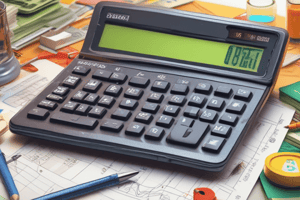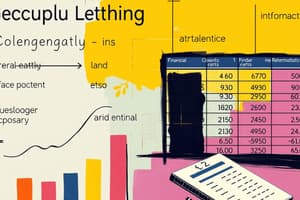Podcast
Questions and Answers
Which type of account is closed at the end of the accounting period?
Which type of account is closed at the end of the accounting period?
- Principal account
- Clearing account
- Nominal account (correct)
- Mixed account
What is the purpose of a controlling account?
What is the purpose of a controlling account?
- To transfer data from the journal to the appropriate accounts in the general ledger
- To hold temporarily certain information pending for disposition
- To summarize the detailed information in a subsidiary ledger (correct)
- To provide additional detail in support of certain general ledger accounts
Which type of account cannot stand alone and is technically neither assets, liabilities nor income and expenses?
Which type of account cannot stand alone and is technically neither assets, liabilities nor income and expenses?
- Reciprocal account
- Auxiliary account (correct)
- Suspense account
- Summary account
What is the process of transferring data from the journal to the appropriate accounts in the general ledger and subsidiary ledger called?
What is the process of transferring data from the journal to the appropriate accounts in the general ledger and subsidiary ledger called?
Which ledger includes all the accounts appearing on the financial statements?
Which ledger includes all the accounts appearing on the financial statements?
Which type of account holds temporarily certain information pending transfer to other ledger accounts?
Which type of account holds temporarily certain information pending transfer to other ledger accounts?
Which type of account has a counterpart in another book within the entity or in another ledger or another entity?
Which type of account has a counterpart in another book within the entity or in another ledger or another entity?
Which type of account is independent or can stand alone?
Which type of account is independent or can stand alone?
Which type of account is a combination of real and nominal accounts?
Which type of account is a combination of real and nominal accounts?
What is the purpose of a subsidiary ledger?
What is the purpose of a subsidiary ledger?
Which phase of the accounting cycle involves recording and summarizing transactions?
Which phase of the accounting cycle involves recording and summarizing transactions?
What is the purpose of a journal in accounting?
What is the purpose of a journal in accounting?
Which special journal is used to record only sales of merchandise on account?
Which special journal is used to record only sales of merchandise on account?
What type of journal entry contains a single debit and a single credit element?
What type of journal entry contains a single debit and a single credit element?
Which accounts are not closed and carry over to the next accounting period?
Which accounts are not closed and carry over to the next accounting period?
What is the equation that represents the financial position of a company?
What is the equation that represents the financial position of a company?
Which phase of the accounting cycle involves analyzing the transaction and determining its impact on the financial position?
Which phase of the accounting cycle involves analyzing the transaction and determining its impact on the financial position?
Which special journal is used to record all types of cash receipts?
Which special journal is used to record all types of cash receipts?
What is the purpose of a compound journal entry?
What is the purpose of a compound journal entry?
Which type of account is a statement of financial position or so-called permanent account?
Which type of account is a statement of financial position or so-called permanent account?
Flashcards are hidden until you start studying
Study Notes
Accounting Accounts
- Temporary accounts, such as revenue, expense, and dividend accounts, are closed at the end of the accounting period.
- A controlling account is a general ledger account that summarizes and controls the subsidiary ledger accounts.
- A contra account is a type of account that cannot stand alone and is technically neither an asset, liability, nor income and expense.
Ledger and Journal
- The process of transferring data from the journal to the appropriate accounts in the general ledger and subsidiary ledger is called posting.
- The general ledger includes all the accounts appearing on the financial statements.
- A subsidiary ledger holds temporarily certain information pending transfer to other ledger accounts.
- A reciprocal account has a counterpart in another book within the entity or in another ledger or another entity.
- A real account is an independent or standalone account.
- A mixed account is a combination of real and nominal accounts.
Ledger Purpose
- The purpose of a subsidiary ledger is to provide detailed information about a particular type of transaction or account.
Accounting Cycle
- The phase of the accounting cycle that involves recording and summarizing transactions is called journalizing.
- The purpose of a journal in accounting is to record transactions in chronological order.
- The sales journal is a special journal used to record only sales of merchandise on account.
- A simple journal entry contains a single debit and a single credit element.
- Permanent accounts, such as asset, liability, and equity accounts, are not closed and carry over to the next accounting period.
- The equation that represents the financial position of a company is Assets = Liabilities + Equity.
Journalizing
- The phase of the accounting cycle that involves analyzing the transaction and determining its impact on the financial position is called journalizing.
- The cash receipts journal is a special journal used to record all types of cash receipts.
- The purpose of a compound journal entry is to record multiple transactions or multiple debit and credit elements in a single entry.
Financial Statements
- A balance sheet is a statement of financial position or a so-called permanent account.
Studying That Suits You
Use AI to generate personalized quizzes and flashcards to suit your learning preferences.




